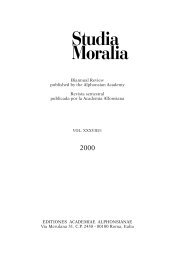Avant-propos - Studia Moralia
Avant-propos - Studia Moralia
Avant-propos - Studia Moralia
Create successful ePaper yourself
Turn your PDF publications into a flip-book with our unique Google optimized e-Paper software.
THE HEALING ROLE OF FRIENDSHIP 65<br />
venerable tradition of philosophical and theological expression.<br />
He casts his teaching in this literary genre because he desires a<br />
flexible way of expressing his very particular concerns about the<br />
nature of human relationships. Those concerns are closely connected<br />
with what Jean Leclercq terms “monastic theology,” a<br />
broad, descriptive phrase used to distinguish the practical, experiential,<br />
and symbolic interests of the cloister setting from the<br />
more theoretical, abstract, and dialectical interests of the<br />
scholastic aula. 5 The two approaches differ in fundamental<br />
ways. Monastic theology values the epistemological role of love<br />
and looks upon learning as a means to holiness. Scholastic theology,<br />
in turn, while having nothing against the pursuit of holiness,<br />
sees it as only ancillary to the specific goal of theology itself,<br />
which is to clarify the objective content of the faith through<br />
a critical use of dialectical reasoning. 6 In the twelfth century, the<br />
dialogue form was used very creatively and to great benefit by<br />
monastic and scholastic authors alike. 7<br />
Aelred’s interests in using the dialogue form coincide closely<br />
with his practical interest as a monastic author in showing his<br />
readers how friendship can heal them and draw them closer to<br />
Christ. A close examination of his treatise shows that he departs<br />
from the general characteristics of monastic theology only in his<br />
general hesitancy to incorporate allegorical interpretations into<br />
his text. Since he employs such interpretations in many of his<br />
Desire for God, trans. Catharine Misrahi (New York: Fordham University<br />
Press, 1982), 153-54. For the dialogue as a literary form, see IRWIN EDMAN,<br />
ed., “Introduction” in The Works of Plato (New York: Tudor Publishing Company,<br />
1931), xxiii-xxvi.<br />
5 LECLERCQ, The Love of Learning, 191-235.<br />
6 For a comparison of monastic and scholastic theology, see B. P. GAYBBA,<br />
Aspects of the History of Theology: 12 th -14 th Centuries (Pretoria: University of<br />
South Africa, 1988), 52-57. See also JEAN LECLERCQ, “Monastic and Scholastic<br />
Theology in the Reformers of the Fourteenth to Sixteenth Century,” in<br />
From Cloister to Classroom: Monastic and Scholastic Approaches to Truth, ed.<br />
E. Rozanne Elder, The Spirituality of Western Christendom III (Kalamazoo,<br />
MI: Cistercian Publications, 1986), 178-201, esp. 194.<br />
7 Compare, for example, DSA with PETER ABELARD’S Dialogus inter<br />
philosophum, iudaeum et christianum, ed. R. Thomas (Stuttgart-Bad-<br />
Cannstatt: Friedrich Frommann, 1970).

















